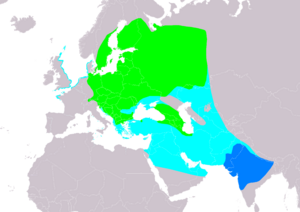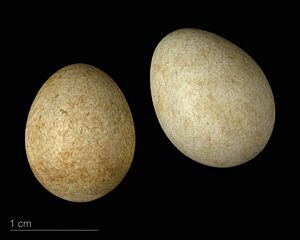Red-breasted flycatcher facts for kids
The Red-breasted Flycatcher (Ficedula parva) is a small, colorful bird. It belongs to a group of birds called Old World flycatchers. These birds are known for catching insects in the air.
Quick facts for kids Red-breasted flycatcher |
|
|---|---|
 |
|
| Conservation status | |
| Scientific classification | |
| Genus: |
Ficedula
|
| Species: |
parva
|
 |
|
| Range of F. parva Breeding Passage Non-breeding Extant & Origing uncertain (non breeding) | |
These birds are migratory. This means they travel long distances between seasons. They breed in eastern Europe and across Central Asia. When winter comes, they fly south to warmer places like South Asia. Sometimes, they are seen passing through western Europe on their journey.
Contents
What Does It Look Like?
The Red-breasted Flycatcher is a small bird, about 11–12 centimeters (4-5 inches) long. That's roughly the size of your hand!
Males in Breeding Season
During the breeding season, male Red-breasted Flycatchers are easy to spot. They have a brown back and white belly. Their head is grey, and they have a bright orange throat. Their beak is black and wide, perfect for catching insects.
Females and Young Birds
Female birds and young birds look a bit different. They have brown heads and do not have the orange throat. You can still tell them apart from other flycatchers by their size. They also have a special tail pattern. The tail is white with a dark T-shape on it.
What Do They Eat?
Red-breasted Flycatchers are insect eaters. They are very good at catching insects while flying. They also hunt for caterpillars hiding in oak tree leaves. Sometimes, they even eat berries.
They often perch on branches, looking for their next meal. You might see them flicking their tail upwards. This is a common behavior while they are watching for insects.
Sounds and Songs
In winter, these birds are usually quiet. But they do make a typical "chip-chip-chr-rrr" call. This sound helps them communicate.
During the breeding season, the males sing beautiful, clear whistles. Their song sounds a bit like the European pied flycatcher.
Where Do They Live?
Red-breasted Flycatchers prefer to live in deciduous woodlands. These are forests where trees lose their leaves in autumn. They especially like areas near water.
Reproduction and Nesting
These birds build open nests. They often choose a hole in a tree or a similar hidden spot. A female Red-breasted Flycatcher usually lays 4 to 7 eggs.
Why Are They Called That?
The scientific name for the Red-breasted Flycatcher is Ficedula parva. The word Ficedula comes from Latin. It used to refer to a small bird that ate figs. People thought this bird changed into a blackcap in winter. The word parva is also Latin and simply means "small."



